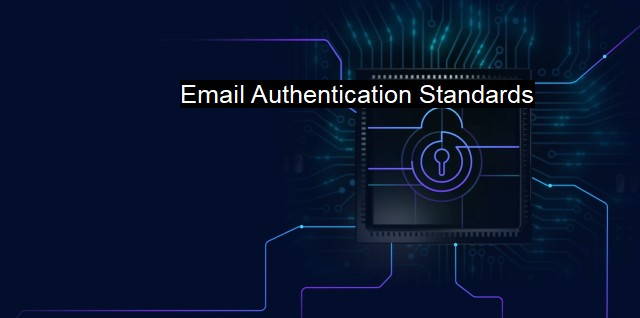What are Email Authentication Standards?
Ensuring Email Security: Understanding the Need for Email Authentication Standards in a Cyber-Insecure World
Email authentication standards are protocols designed to improve email security and protect users and organizations against cyber threats, including spam, phishing, and malware attacks. The bedrock of email authentication standards lies in cybersecurity principles and antivirus solutions. Some common standards include Sender Policy Framework (SPF), DomainKeys Identified Mail (DKIM), and Domain-Based Message Authentication, Reporting, and Conformance (DMARC).The broad goal of email authentication standards is to ensure that email content originates from the domain it claims to come from. A failure in this verification leads to growing cybersecurity threats, creating severe consequences for businesses and individuals.
Firstly, the Sender Policy Framework (SPF), a simple yet valuable security standard, identifies and mitigates the risk of spoofing - a practice where attackers camouflage as an eCommerce website or a social network. Thereby, bypassing traditional filters and tricking unsuspecting users into revealing confidential information. SPF enables the receiving mail servers to check whether incoming mail originating from a domain comes from a host sanctioned by the administrators of that domain. Therefore, if a cybercriminal tries to send a phishing email, SPF detects and blocks it.
The second standard, DomainKeys Identified Mail (DKIM), attaches a digital signature linked to the domain used to send an email. By acting as another level of proof that the email is genuinely from the stated sender, DKIM inhibits cybercriminals from altering the content during transmission. Institutions engaging in vital financial or personal data discussions benefit substantially from this authentication.
The most stringent protocol is the Domain-Based Message Authentication, Reporting, and Conformance (DMARC). Building on SPF and DKIM, DMARC specifies what strategies to apply when email fails SPF or DKIM checks and provides a way for the recipient's email server to report back to the sender's about messages that pass and/or fail the DMARC evaluation. Thus, it protects email traffic as the email failure to pass tests would end up in the spam folder or, at times, gets completely rejected.
Antivirus developers often complement these email authentication standards with a layered detection model, intending to deflect cyber threats even more complex than emails. Algorithms identify deviations from the standard email structures and procedures, alerting users and administrators of any potential phishing or spoofing attempts.
Meticulously implemented, email authentication standards significantly reduce the risks of receiving malicious content for the users of corporate and private networks alike. These technologies demand a prioritized adoption, especially during the recent times marked by intense digitization and all the resulting opportunities for cybercrime activities.
It is also noteworthy that no online protection measure implies absolute security – email authentication merely decreases the chances of unwanted intrusion. Yet, the cybersecurity premise being an indisputable blend of advanced technology usage and educated user behaviors, the implementation of these three key email authentication standards greatly contributes to shielding users from identity thefts, ensuring the integrity of the email ecosystem, and maintaining the trust that lays the foundation of digital communications.
Email authentication standards introduce an additional layer of necessary security within the cybersecurity and antivirus context. Organizations and individuals must understand their significance and innovate continuously to accommodate for the rapidly evolving cyber-threat landscape. As part of a broad cyber protection approach, the wide-scale adoption of SPF, DKIM, and DMARC plays an integral part in promoting safe online practices, securing digital assets, and organizing a firm-line against an escalating volume of email-borne attacks.

Email Authentication Standards FAQs
What is email authentication and why is it important in cybersecurity?
Email authentication is a set of standards and protocols that help verify the authenticity of an email message and its sender. It is important in cybersecurity because it helps prevent email fraud, phishing attacks, and other malicious activities that can compromise an organization's network security.What are some common email authentication standards?
Some common email authentication standards include SPF (Sender Policy Framework), DKIM (DomainKeys Identified Mail), and DMARC (Domain-based Message Authentication, Reporting & Conformance).What is SPF and how does it work?
SPF (Sender Policy Framework) is an email authentication standard that allows domain owners to specify which IP addresses are authorized to send email on their behalf. When an email is received, the receiving server can check the SPF record for the sender's domain to see if the email was sent from an authorized source.What is DMARC and how does it enhance email authentication?
DMARC (Domain-based Message Authentication, Reporting & Conformance) is an email authentication standard that builds upon SPF and DKIM by providing a policy framework for how email receivers should handle messages that fail authentication checks. DMARC enables domain owners to specify how they want email from their domain to be handled if it fails SPF or DKIM checks, and also provides reporting mechanisms to help domain owners monitor and improve their email authentication practices.| | A | | | B | | | C | | | D | | | E | | | F | | | G | | | H | | | I | | | J | | | K | | | L | | | M | |
| | N | | | O | | | P | | | Q | | | R | | | S | | | T | | | U | | | V | | | W | | | X | | | Y | | | Z | |
| | 1 | | | 2 | | | 3 | | | 4 | | | 7 | | | 8 | | |||||||